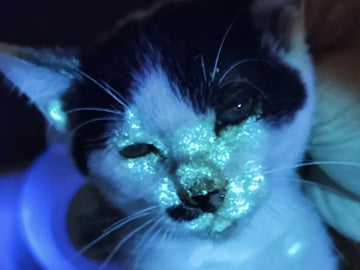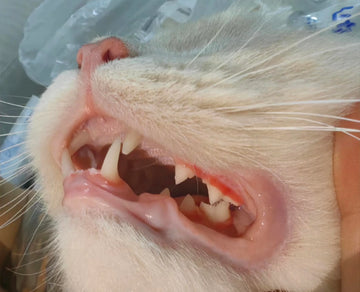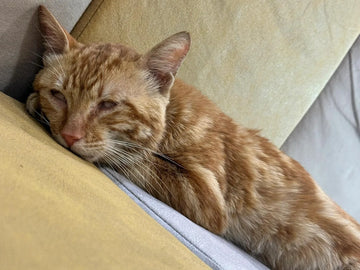Updated Oct 2025 · Read time ~16–20 minutes
I caught ringworm from my cat. That sentence still feels strange to type, but it’s true — and it’s the reason I’m writing this: to walk you through what it looks like at the very beginning, how we confirmed the diagnosis, how we treated both my cat and me, and the disinfecting routine that finally stopped the cycle in our home. If you’re here at 2 a.m. with a new scab on your cat or a strange itchy patch on your skin, this is written for you — practical, U.S.-friendly, and no fluff.
What is ringworm (a quick, clear definition)
“Ringworm” is a common name for dermatophytosis, a fungal infection caused by dermatophyte species (like Microsporum and Trichophyton). In cats it most often shows as circular, scaly lesions and localized hair loss. It’s not a worm — it’s a fungus that eats keratin on skin and hair.
Important: ringworm is contagious to other animals and to people. It can survive in the environment (hair, bedding, carpets) for months unless you actively disinfect.
What ringworm looks like on cats — the stages I saw (and photographed)
My cat's first lesion was tiny — the sort of scab you might ignore. Because I’d seen dermatology photos online only for advanced lesions, I almost missed it. Here’s the practical progression:
Early (one small itchy bump)
- Small, scabby bump or flaky spot under the fur.
- Sometimes very itchy — the cat may scratch or groom obsessively.
- Often on the face, ears, or paws but can appear anywhere.
Second stage (itching → redness → broken skin)
- Scratching breaks the skin; you get red raw patches with crusting.
- Hair may fall out locally; the edges might be slightly raised.
Late/typical (classical ring)
- Roundish, well-defined patch with central healing and active red/scaly ring at the edge.
- May expand and coalesce into larger scaly areas if untreated.
Tip from my experience: early ringworm can look like a pimple or an insect bite. If a scab or flaky patch isn't improving in a few days, get it checked — early treatment shortens contamination time.

Is ringworm contagious to people? Who is at risk?
Yes — ringworm is zoonotic. I learned this the hard way: after a week of treating my cat, I developed a small round itchy patch on my forearm. It looked like a red ring and was intensely itchy. That’s how I knew I’d had direct transmission.
Who is most at risk?
- Young children — they cuddle pets and may have immature immunity.
- Older adults or people with chronic conditions.
- People on immunosuppressive medicines (steroids, chemotherapy, biologics).
- People with broken skin or eczema.
If someone in the household is immunocompromised, inform your doctor and prioritize rapid veterinary care and home disinfection. In my case we isolated the cat and used gloves liberally until the infection was controlled.
How veterinarians confirm ringworm (what to expect at the clinic)
My vet used three approaches; together they tell the story. No single test is perfect, so vets often combine methods:
1) Wood’s lamp (quick screening)
A Wood’s lamp emits ultraviolet light. Some strains of Microsporum canis fluoresce a green color in infected hairs. It’s fast and helpful, but not all dermatophytes fluoresce — false negatives happen. We had a few fluorescent hairs and that pushed the vet to test further.
2) Fungal culture (gold standard)
A fungal culture from plucked hairs or a scalpel-scrape is the most reliable diagnostic tool. It takes 1–2 weeks, but it confirms the species and helps verify cure (we did two negative cultures before declaring victory). Expect the clinic to send the sample to a lab and call with results.
3) PCR / lab testing
PCR testing for dermatophyte DNA is faster and sensitive, and many clinics offer it. It complements culture and is useful for tricky or early cases.
Clinical judgement
Sometimes vets will start treatment based on appearance + Wood's lamp while awaiting culture, especially if there are other ill animals in the household. That was our path: we started topical care immediately and adjusted systemic therapy when culture confirmed the diagnosis.

Treatment options: what works for cats (and what worked for us)
Treatment is twofold: treat the cat (topicals and sometimes oral medication) and clean the environment to remove spores. I'll walk you through both and share my exact home routine.
Topical therapy (first-line for mild, localized lesions)
- Antifungal creams such as miconazole or clotrimazole applied to lesions twice daily. We used a veterinary topical cream recommended by our clinic and applied with a gloved finger.
- Lime sulfur dips — a classic veterinary dip that kills spores on the haircoat. It smells and stains, but it’s very effective. If your vet suggests dips, have them show you how; they often prefer clinic administration the first time.
Systemic antifungals (when vets prescribe oral medication)
For widespread infections, kittens, or stubborn cases, veterinarians commonly prescribe oral antifungals such as itraconazole or terbinafine. These drugs are prescribed by weight and monitored with bloodwork because they can affect the liver. Do not give human antifungals without veterinary guidance. In my case our vet started a short course of oral terbinafine because the lesions were multiple and I wanted to stop spread quickly.
Elizabethan collar and preventing self-trauma
My cat tried constantly to lick treated areas; we used an Elizabethan collar (cone) until lesions scabbed and stopped expanding. The cone is annoying for them but crucial — licking spreads spores and interrupts healing.
Treating humans
My doctor recommended a topical antifungal cream (over-the-counter clotrimazole) for my ring-shaped rash. I applied twice daily for two weeks and it resolved. If a lesion is large, spreading rapidly, or your immune system is weak, see a physician — they may give a prescription-strength topical or oral antifungal.
Treatment duration & cure confirmation
- Mild localized cases: topical therapy 2–4 weeks plus environmental cleaning.
- Widespread or household outbreaks: systemic therapy for several weeks (often 4–8 weeks or until two negative fungal cultures are obtained at least 2 weeks apart).
In our household we used a combined approach: weekly lime-sulfur dips (clinic), topical cream at home for the visible spots, an oral antifungal for three weeks, and strict cleaning. We kept the cone on for the first ten days. After two negative cultures and two clean weeks of no new lesions, we stopped treatment.
Cleaning & environmental control: stop it surviving in the house
This was the hardest part. Fungal spores live on hair and in carpet, bedding, soft toys, and upholstery — and they can persist for months. You must treat the environment aggressively to break the cycle.
Daily & weekly routine we used
- Vacuum daily — hair removal reduces spores in carpets and upholstery. Empty or wash the vacuum canister after each use (outdoors if possible).
- Launder all bedding, soft toys, and removable covers on the hottest safe setting and dry on high heat. Use detergent plus a cup of white vinegar as an extra measure.
- Disinfect hard surfaces — diluted bleach (follow label guidance) or a fungicidal disinfectant labeled for dermatophytes. Many shelters recommend a household bleach solution (follow product instructions) or commercial antifungal cleaners. I alternated between hypochlorite wipes on tiles and a veterinary-grade disinfectant for wood and laminate surfaces.
- Steam-clean carpets and upholstery where possible — heat helps kill spores.
- Isolate infected animals to one room until cultures clear. Limit access to furniture and soft surfaces in the shared house.
On products & safety
Read labels. Some strong disinfectants are harsh around kids or sensitive pets — ventilate rooms and follow PPE guidelines (gloves, good ventilation). If someone in your household is pregnant or immunosuppressed, consult their physician and your vet about extra precautions.
How long to keep cleaning
Continue intensive cleaning until you have two negative cultures from the pet (or veterinarian guidance). In our experience, maintain strict cleaning for at least 6–8 weeks.
My timeline & costs — the real numbers (U.S.-style estimate)
Every case is different, but I promised to be transparent about what we spent and when things improved. I live in a mid-sized U.S. city; prices will vary.
| Item | What it covered | Approx cost (USD) |
|---|---|---|
| Initial vet visit + Woods lamp | Exam, Wood's lamp screening | $75–$150 |
| Fungal culture / lab | Plucked hairs / culture (1–2 weeks) | $45–$120 |
| Topical meds | Creams, sprays, ointment | $20–$50 |
| Oral antifungal (if prescribed) | Itraconazole or terbinafine course (weeks) | $40–$200 |
| Clinic lime-sulfur dip | Weekly dip (if used) | $25–$60 per visit |
| Cleaning supplies | Disinfectant, laundry, vacuum bags | $60–$150 |
Our total out-of-pocket costs landed around $350–$700 depending on whether you require systemic meds and professional dips. Worth every penny — the peace and health of our family matter more than a discount.
Holiday & long-weekend tips (Independence Day, Thanksgiving, Christmas)
Planning to travel for July 4 or another long weekend? Make sure you have prescriptions refilled at least one week early. Emergency clinics may be open but busy; have a backup clinic and transport plan. We couldn’t refill one topical because the clinic was closed two days — don’t let that happen to you.
- Refill topical and oral meds before the holiday.
- Bring printed lab results and culture info if traveling with a sick cat.
- Pack spare bedding in a sealed bag and a travel laundry kit.
FAQ — quick answers from our experience
Q: Can I treat ringworm at home without a vet?
A: For the tiniest spot you might try topical antifungal and close monitoring, but vet confirmation is wise — especially if it spreads or you have children or immunocompromised people at home.
Q: How long before my skin clears if I get infected?
A: With topical antifungal cream, human lesions usually improve within 1–3 weeks, sometimes longer. See your PCP if it spreads or symptoms are severe.
Q: My other cat looks fine — do I treat them?
A: Your vet may recommend screening (Wood's lamp, culture) of housemates and preventive bathing/dips or topical therapy for exposed animals. Sometimes asymptomatic carriers spread spores.
Q: Are there serious complications?
A: In healthy adults: rarely. In babies, elderly, or immunocompromised people: fungal infections can be more severe and should be treated by a physician. In cats, untreated widespread disease can be stubborn and prolong household contamination.
Related reading & resources
- For stomach-illness differentials and when GI symptoms are primary, see our Cat Gastroenteritis guide.
- If you’re worried about severe systemic infection or concurrent diseases, read about Cat’s FIP (different disease but similar urgency mindset).
- Safety-proof your home with tips from Cat Safety at Home.
Printable quick checklist (what I packed into my treatment box)
Vet Visit: appointment card, current photo of lesion, list of meds, symptom timeline
At-home Care box:
- disposable gloves (box)
- topical antifungal cream
- Elizabethan collar (two sizes)
- antiseptic wipes and disinfectant
- laundry bags (sealed)
- soft towels, extra bedding
- digital thermometer for cat (rectal) & notebook to track progress
- phone list: vet clinic, emergency clinic, pharmacy




